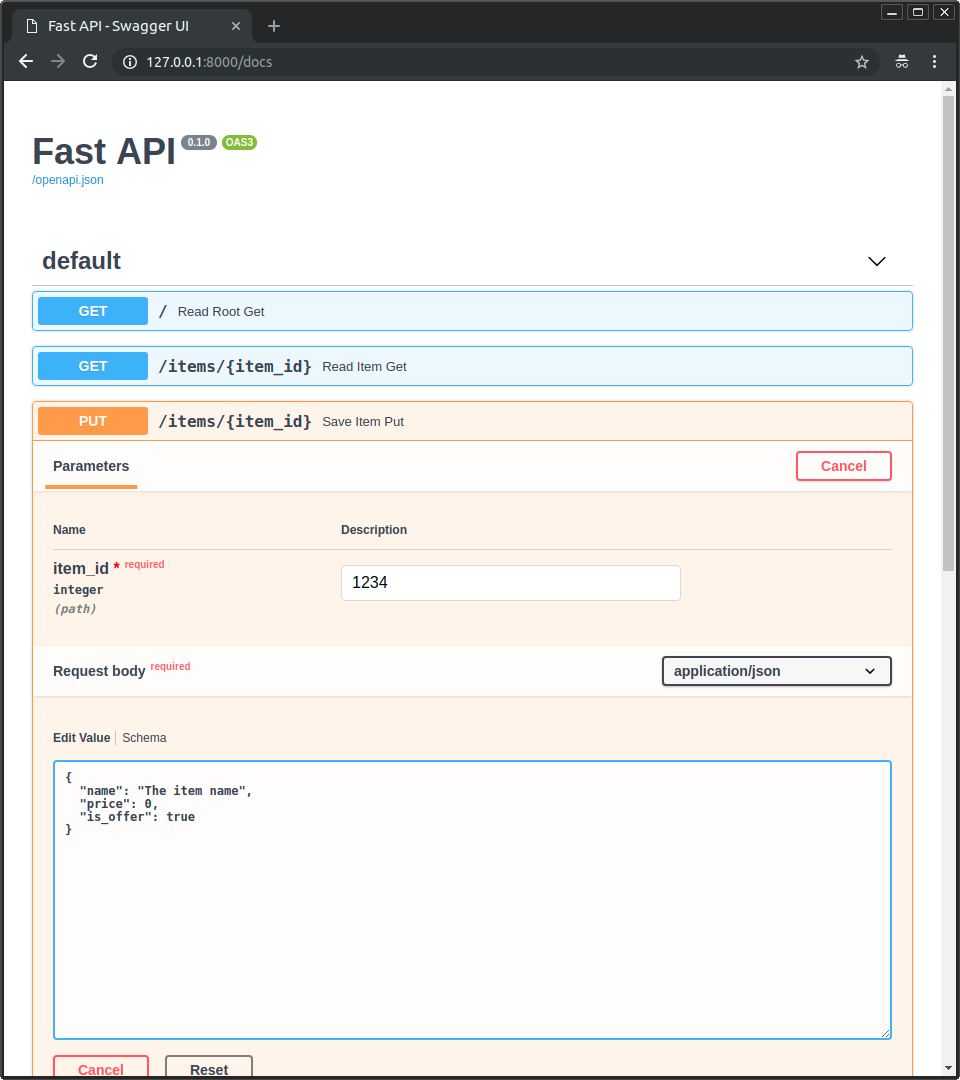- Sort Score
- Result 10 results
- Languages All
Results 1 - 10 of 31 for sakeen (0.2 sec)
-
docs/en/docs/tutorial/body-multiple-params.md
```Python hl_lines="19-21" {!> ../../../docs_src/body_multiple_params/tutorial001.py!} ``` !!! note Notice that, in this case, the `item` that would be taken from the body is optional. As it has a `None` default value. ## Multiple body parameters In the previous example, the *path operations* would expect a JSON body with the attributes of an `Item`, like: ```JSON {Plain Text - Registered: Sun Apr 28 07:19:10 GMT 2024 - Last Modified: Tue Oct 17 05:59:11 GMT 2023 - 7.7K bytes - Viewed (0) -
docs/de/docs/tutorial/response-model.md
Plain Text - Registered: Sun Apr 28 07:19:10 GMT 2024 - Last Modified: Sat Mar 30 20:26:58 GMT 2024 - 19.9K bytes - Viewed (0) -
docs/en/docs/tutorial/security/oauth2-jwt.md
You can learn how to use them and how they are integrated into **FastAPI** later in the **Advanced User Guide**. ## Recap With what you have seen up to now, you can set up a secure **FastAPI** application using standards like OAuth2 and JWT. In almost any framework handling the security becomes a rather complex subject quite quickly.
Plain Text - Registered: Sun Apr 28 07:19:10 GMT 2024 - Last Modified: Thu Apr 18 19:53:19 GMT 2024 - 13K bytes - Viewed (0) -
docs/de/docs/tutorial/query-params-str-validations.md
``` Beachten Sie, dass der Defaultwert immer noch `None` ist, sodass der Parameter immer noch optional ist.
Plain Text - Registered: Sun Apr 28 07:19:10 GMT 2024 - Last Modified: Sat Mar 30 17:58:59 GMT 2024 - 27.7K bytes - Viewed (0) -
docs/en/docs/release-notes.md
* This allows declaring a parameter like `user_id: str = None` that can be taken from a query parameter, but the same *path operation* can be included in a router with a path `/users/{user_id}`, in which case will be taken from the path and will be required. * PR [#464](https://github.com/tiangolo/fastapi/pull/464) by [@jonathanunderwood](https://github.com/jonathanunderwood).Plain Text - Registered: Sun Apr 28 07:19:10 GMT 2024 - Last Modified: Sun Apr 28 00:28:00 GMT 2024 - 385.5K bytes - Viewed (1) -
docs/en/docs/advanced/templates.md
{!../../../docs_src/templates/templates/item.html!} ``` ### Template Context Values In the HTML that contains: {% raw %} ```jinja Item ID: {{ id }} ``` {% endraw %} ...it will show the `id` taken from the "context" `dict` you passed: ```Python {"id": id} ``` For example, with an ID of `42`, this would render: ```html Item ID: 42 ``` ### Template `url_for` ArgumentsPlain Text - Registered: Sun Apr 28 07:19:10 GMT 2024 - Last Modified: Thu Jan 11 22:25:37 GMT 2024 - 3.2K bytes - Viewed (0) -
docs/en/docs/advanced/behind-a-proxy.md
```JSON { "message": "Hello World", "root_path": "/api/v1" } ``` !!! tip Notice that even though you are accessing it at `http://127.0.0.1:8000/app` it shows the `root_path` of `/api/v1`, taken from the option `--root-path`. And now open the URL with the port for Traefik, including the path prefix: <a href="http://127.0.0.1:9999/api/v1/app" class="external-link" target="_blank">http://127.0.0.1:9999/api/v1/app</a>.Plain Text - Registered: Sun Apr 28 07:19:10 GMT 2024 - Last Modified: Thu Apr 18 19:53:19 GMT 2024 - 11.6K bytes - Viewed (2) -
docs/en/docs/index.md
 * Then click on the "Execute" button, the user interface will communicate with your API, send the parameters, get the results and show them on the screen:  ### Alternative API docs upgrade
Plain Text - Registered: Sun Apr 28 07:19:10 GMT 2024 - Last Modified: Thu Apr 18 23:58:47 GMT 2024 - 19.2K bytes - Viewed (0) -
docs/de/docs/python-types.md
``` Python selbst macht nichts mit `Annotated`. Für Editoren und andere Tools ist der Typ immer noch `str`. Aber Sie können `Annotated` nutzen, um **FastAPI** mit Metadaten zu versorgen, die ihm sagen, wie sich ihre Anwendung verhalten soll. Wichtig ist, dass **der erste *Typ-Parameter***, den Sie `Annotated` übergeben, der **tatsächliche Typ** ist. Der Rest sind Metadaten für andere Tools.
Plain Text - Registered: Sun Apr 28 07:19:10 GMT 2024 - Last Modified: Sat Mar 30 20:29:25 GMT 2024 - 19.3K bytes - Viewed (0) -
docs/en/docs/tutorial/sql-databases.md
These ORMs also have tools to make the connections or relations between tables or entities. This way, you could also have an attribute `orion_cat.owner` and the owner would contain the data for this pet's owner, taken from the table *owners*. So, `orion_cat.owner.name` could be the name (from the `name` column in the `owners` table) of this pet's owner. It could have a value like `"Arquilian"`.
Plain Text - Registered: Sun Apr 28 07:19:10 GMT 2024 - Last Modified: Thu Apr 18 19:53:19 GMT 2024 - 29.6K bytes - Viewed (0)